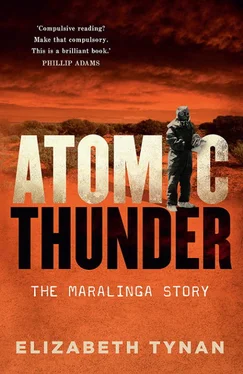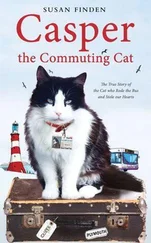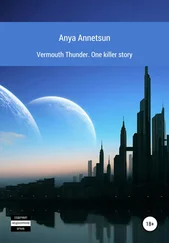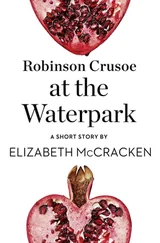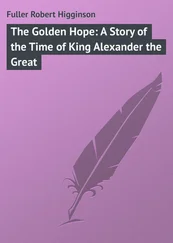the closure of the mission at Ooldea Soak in June 1952 in order to remove several hundred Aborigines further south to Yalata mission… was of considerable anthropological significance. This was because rapid dislocation from their homelands caused confusion and distress among the Ooldea people which is held to be a major reason for the depressed and unhealthy state of the contemporary Yalata community – and is reflected also in other settlements containing dislocated Aborigines, for instance Cundalee [ sic ], Gerard and Ernabella.
The Aboriginal people of the Maralinga lands had complex ties to this arid place. Numerous groups of about 25 men, women and children constantly traversed the territory, encountering each other and reforming into new groups. At important ceremonial occasions, smaller groups also merged together for short times. As Europeans started to infiltrate the area in the 19th and early 20th centuries, some new patterns of Aboriginal activity began to develop. The opening up of pastoral stations brought the prospect of paid work for the first time, and the transcontinental railway offered opportunities for trade. Also, new movements of people were detected from the Warburton Ranges and the Gibson Desert towards Laverton, Mt Margaret, Kalgoorlie and Wiluna. People started travelling from Oodnadatta to Granite Downs too. In general, the early part of the 20th century saw considerable change in the way traditional owners moved around the land. The arrival of Europeans disrupted aeons-old movement patterns.
When the enormous Woomera Prohibited Area was declared in 1946, there were perhaps not as many Indigenous people pursuing traditional ways of life on the territory covered by the range as there had been 50 years before. But they had not ceased. The Royal Commission report found, ‘The country was still used for hunting and gathering, for temporary settlements, for caretakership and spiritual renewal, and for traverse by people who moved from locations to other areas within and outside what became the prohibited areas’.
The Woomera project potentially affected far more people than that at Maralinga, since it involved firing rockets hundreds of kilometres across the centre of Australia. In February 1947 a meeting brought together various state and federal government authorities concerned with Aboriginal affairs, along with the anthropologists Professor AP Elkin, of Sydney University, and Dr Donald Thomson, and a Scottish medical doctor and Aboriginal rights campaigner, Charles Duguid. Duguid had campaigned against the land being used for rocket testing since 1946 and was a strong advocate for the Indigenous peoples. The meeting discussed two main issues: the physical danger from falling or exploding missiles and the acceleration of ‘the de-tribalisation process in an uncontrolled and destructive fashion’. Duguid and Thomson, in particular, were concerned that testing military weaponry in the area would fatally disrupt the traditions of the Aboriginal inhabitants. Duguid fought hard against the proposal and resigned from the Aborigines Protection Board when he was unsuccessful. The upshot from that meeting was the creation of the position of native patrol officer in the federal Department of Supply.
Walter MacDougall was appointed, initially temporarily, as the first native patrol officer, beginning a legendary career. Tall, thin, gingery and very, very white-skinned, he was based out of Woomera. He carried the scars of an outback life – he was missing his right thumb and forefinger after accidentally blowing them off with his Winchester rifle out bush. He began work without even a designated vehicle and had to make increasingly long trips (sometimes over 6400 kilometres) alone. He was intelligent, empathetic and dedicated, and wrote long and impassioned reports and letters about his work. His was one of the few voices raised in support of the Aborigines during the rocket and atomic bomb tests. Government officials and scientists working on the tests saw Indigenous people as no more than a slight inconvenience.
MacDougall’s particular way of interacting with Aborigines looks paternalistic today and shows signs of what we would call tough love. However, there seems little doubt that he cared deeply about the plight of the people being displaced by the atomic tests and did everything in his meagre power to try to curtail the harm done. He advised them about safe places to move to, adjudicated on disputes, hired some Indigenous people for pay and food, administered medical help when able, ferried people to doctors for more serious conditions and generally kept an eye on the welfare of the Indigenous groups who passed through the Maralinga lands. Most of the medical emergencies he encountered involved spear wounds, poisoned limbs, split heads, burns and pneumonia. His reports provide a candid and often wry glimpse into the lives of people affected by the bomb tests.
The territory affected was huge. Its outer extremes stretched across to Kalgoorlie in Western Australia, Port Augusta in South Australia and Alice Springs and the Canning Stock Route in the Northern Territory, an area referred to at the time as Western Central Australia, the Central Aboriginal Reserve or the Western Reserve. The areas under threat were centred on Warburton and Ernabella missions, at the eastern end of the Musgrave Ranges not far from the Northern Territory border. The northern limit of the Maralinga Prohibited Area passed through the southern portion of the Central Aboriginal Reserve. Howard Beale claimed the area was ‘so arid and waterless’ that Aboriginal people did not use it. That was simply untrue.
MacDougall was a remarkable part of the story, and his compassion for the Indigenous people (even if tempered by condescension) made him incongruous. He was appointed a protector of Aborigines by South Australia in November 1947, after the Woomera tests began but well before the British atomic tests were planned for Australia. He was later awarded this same authority by the government in Western Australia. These appointments enabled MacDougall to enter or remain within the boundaries of any Aboriginal reserve or institution, in either state. He travelled extensively throughout the vast territory affected by the Maralinga and Woomera tests – a territory that eventually grew to around 800 000 square kilometres – and got to know the people well.
In a sense, he had a hopeless task. There was really nothing Mac-Dougall could do to save the inhabitants of the area from the vast and rapidly moving British juggernaut. It would roll over anyone in its way, especially people who were unrepresented in Australian society. That he took on the doomed job, and did it for years to the best of his ability in a harsh country, is a measure of his passion and dedication.
In 1954, the permanent test site had been newly named, surveyed and prepared for what was to come as MacDougall set out his views on the unfolding tragedy of the Aborigines of the Maralinga lands:
Contact with white men has so far resulted in degeneration of the aborigines… Because of their own socialistic way of life, the generosity of their friends and friends’ employers, and government rations, they inevitably adopt the routine of moving from Station to Station for free food. The result is laziness, uselessness and loss of self-respect. They neither hunt nor work for their food and the evils of unemployment of able-bodied men are never brought home to them.
MacDougall drew a sharp distinction between the tribal Aborigines, whom he mostly admired and whose lifestyle he considered to be healthy and in tune with their environment, and the ‘fringe natives’, who had been corrupted by the presence of Europeans and who, in his view, had a lesser moral character.
MacDougall’s first nuclear weapons–related survey of January 1953, ahead of the two Totem shots in October that year, found 400 Aboriginal people who made their ‘headquarters’ either at Ernabella and Kenmore Park or Everard Park, Granite Downs and Cullens. According to MacDougall, ‘These people live largely off the land, their only other source of supplies being bounty from dingo scalps and government rations. Their ceremonial life is still very active’. MacDougall proposed a full survey, to determine exactly who was there and to what extent weapons testing would affect their way of life. He asked for a Land Rover with trailer, fuel, tools, camping gear, rations (including a tin of dripping), a rifle, a camera, a compass and a cash advance of £5. The survey would cover 3200 kilometres and take four or five weeks, visiting all the Indigenous camps in the Everard and Musgrave ranges.
Читать дальше
